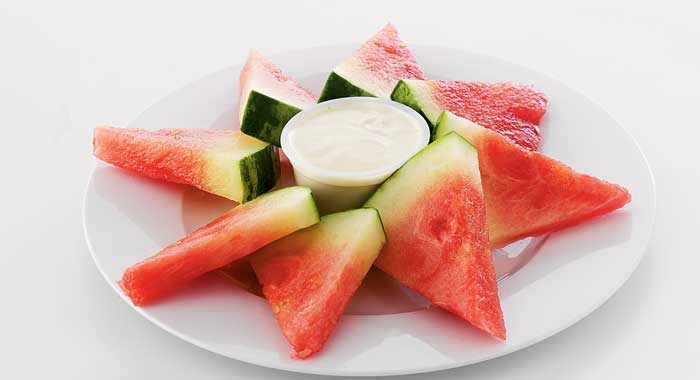
Pronounce it: wort-er-mel-on
Thought to have originated in Africa, watermelons are distinct from musk melons such as cantaloupes, ogens, charantais, galia and honeydew in that they are very watery and have a far less intense flavour. But there are compensations – they can grow to up to six kilogrammes in weight, and their crisp, sweet flesh is phenomenally juicy and refreshing.
Watermelons have a hard green, sometimes striped, rind (which is sometimes used to make pickle) and, inside, the pink or red flesh is dotted with black seeds, which can be toasted and eaten as a snack. The flesh itself is always served raw.
Availability
They are imported all year round, but are at their best from mid June to late August.
Choose the best
Ripe melons should sound hollow when shaken or slapped, and feel heavy for their size. The rind should be dull and shouldn’t give much when pressed. Look for symmetrical melons and avoid those with cracked, spoted or bruised rinds. As they’re often so big, melons are frequently sold halved or quartered, as well as whole. If buying cut melon, look for brightly coloured flesh and black (rather than small white) seeds. Avoid flesh that looks dry or grainy. Green-skinned, red-fleshed watermelons are the most commonly available, but you can also find golden watermelons, which have a bright yellow flesh, though their flavour can be insipid.
Prepare it
Cut in half whichever way you like, then scoop out the seeds, together with any fibrous bits, with a spoon, then slice into wedges.
Store it
If you can fit it in, keep watermelon in the fridge – it should last for up to a week. Otherwise, keep it in the coolest place that you can find. Cut watermelon should always be stored in the fridge, wrapped in clingfilm. Eat within 2-3 days.
Cook it
Watermelon is great cut into wedges; chopped and add to fruit salads; with feta and mint for a sour/sweet salad. Juice.
Alternatives
Try melon.
Be the first to comment on "Watermelon"